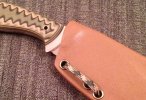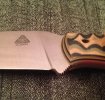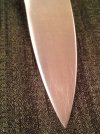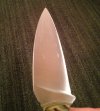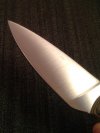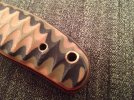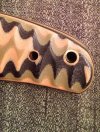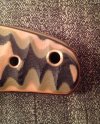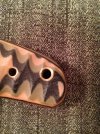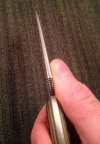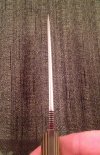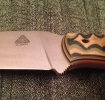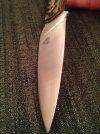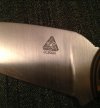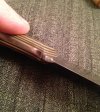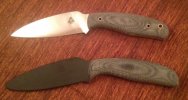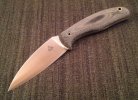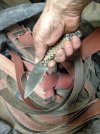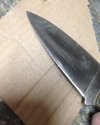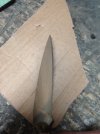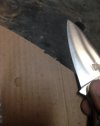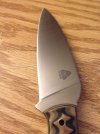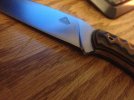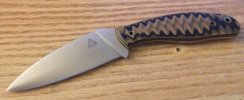- Joined
- Jul 23, 2015
- Messages
- 12,481
I used this one as a daily carry. It does cutting tasks well, and cleans up invasive plants with ease. It's sort of what I thought would be an ideal EDC, for someone who likes knives around 4". I feel like the design worked well enough for its purposes. Mostly cardboard, recycling tasks, or food prep or utility. Looking at it more closely from a review standpoint after all is said and done is hard at first, and trying to highlight imperfections on film was counterintuitive and took a while to realize the proper way to do it. It felt a little counterintuitive to find the right angles and lighting. This one was always meant to be mine from the start. I planned to use it hard to get a feel for the steel, its strengths and limitations.
I used it to open cans, and it would still cut cardboard. It never took anything I could really think of as damage, and rolling seems to hone and strop out very easily.
A few things I noticed about the fit and finish. The sheath was made with pretty narrow tolerances for the blade to avoid the eyelet on the way in or out. Some quick sheath tests found that from certain angles the tendency would be to roll a certain spot on the edge with a quick pull from the sheath along a certain angle. That and it causes recurring scratches. This might have something to do with the fact that I made the sheath is minimal as I thought possible. Minimizing scratches would be nice, though I was guilty of vertical carry in the shop where dust can get in the sheath a few times. Something that isn't a concern for utility purposes, which has been the purpose of this knife, and testing not so meticulously, but through use and general observations. The blade carved wood for me, shaved cardboard, and bent itself out of shape trying to get through tough materials, but always came back with ease. A somewhat bitey edge lasted through what looked and felt like it was too dull to cut like that.
I left the grind a little thin for the first leg of its journey, and recently reground it a bit thinner after a time my confidence in the steel's characteristics grew. I think it is a great knife in a great steel. That's as far as I've come with it.
I reground it some weeks ago, and carried and used it somewhat since. Here they are, photographed a few minutes ago. More pictures and thoughts of what I was thinking, and what I could have done differently.
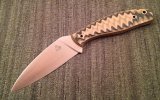
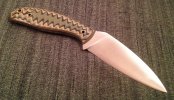
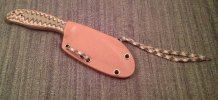
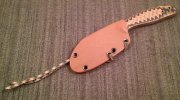
I used it to open cans, and it would still cut cardboard. It never took anything I could really think of as damage, and rolling seems to hone and strop out very easily.
A few things I noticed about the fit and finish. The sheath was made with pretty narrow tolerances for the blade to avoid the eyelet on the way in or out. Some quick sheath tests found that from certain angles the tendency would be to roll a certain spot on the edge with a quick pull from the sheath along a certain angle. That and it causes recurring scratches. This might have something to do with the fact that I made the sheath is minimal as I thought possible. Minimizing scratches would be nice, though I was guilty of vertical carry in the shop where dust can get in the sheath a few times. Something that isn't a concern for utility purposes, which has been the purpose of this knife, and testing not so meticulously, but through use and general observations. The blade carved wood for me, shaved cardboard, and bent itself out of shape trying to get through tough materials, but always came back with ease. A somewhat bitey edge lasted through what looked and felt like it was too dull to cut like that.
I left the grind a little thin for the first leg of its journey, and recently reground it a bit thinner after a time my confidence in the steel's characteristics grew. I think it is a great knife in a great steel. That's as far as I've come with it.
I reground it some weeks ago, and carried and used it somewhat since. Here they are, photographed a few minutes ago. More pictures and thoughts of what I was thinking, and what I could have done differently.





